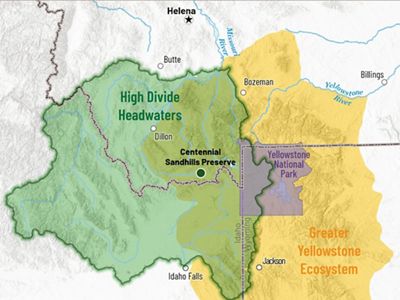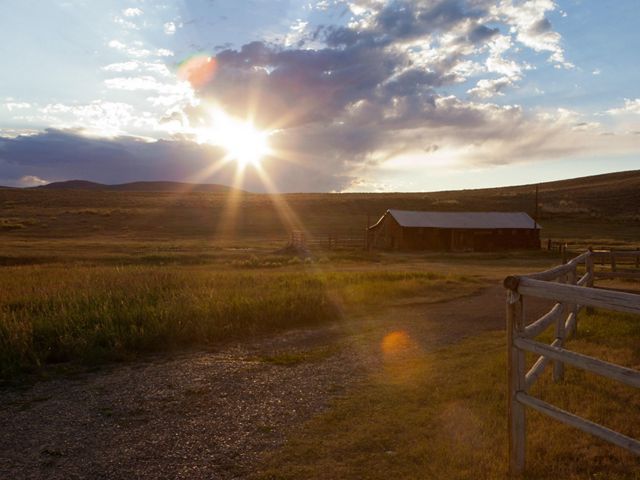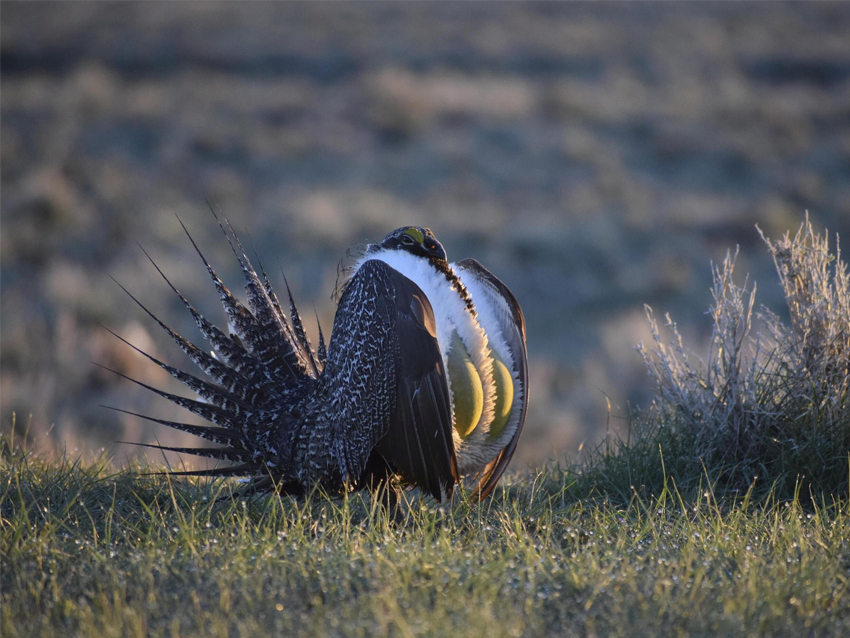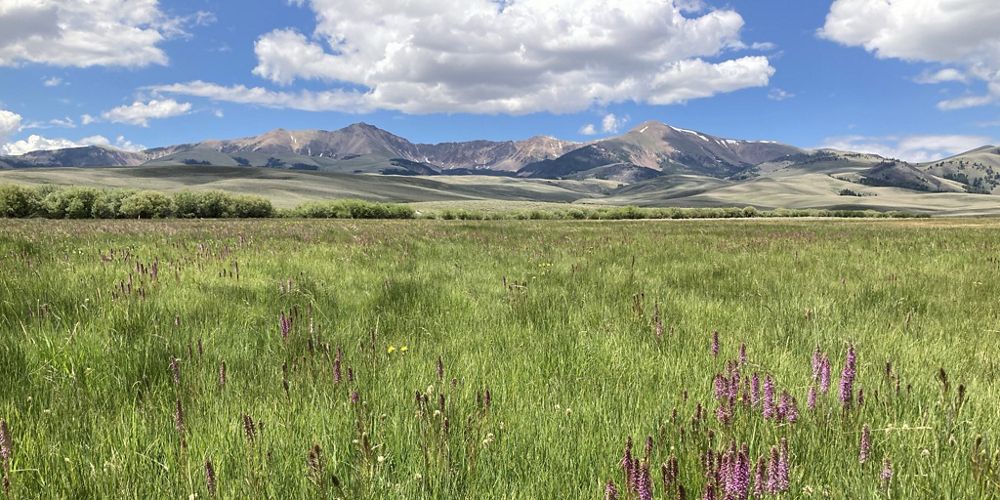Holding the Line: Protecting the Sagebrush Sea
Forests are encroaching into sagebrush landscapes, threatening wildlife that depend on sagebrush habitat. TNC and partners are working to address this issue.

A working wilderness of multi-generational ranches and public lands where wildlife and people thrive.
Rolling westward from Yellowstone and Grand Teton national parks, the High Divide Headwaters is a landscape of wildlife-rich mountain ranges and sagebrush-scented valleys with a proud ranching heritage.

Nestled between the Greater Yellowstone and northern Montana’s Crown of the Continent, the High Divide provides a vital connection between the regions for grizzly bears and wolverines and hosts seasonal migrations of elk, pronghorn and deer. It’s the source of the Missouri River, whose headwaters offer cold, clean water for rare Arctic grayling, a world-class sport fishery and local agriculture. The region is stewarded by multi-generational cattle ranches that are the economic driver of rural Montana and our greatest hope for managing this land at scale.

Our 1,400-acre preserve protects a unique landscape of shifting sand dunes that supports wildlife and rare plants. Learn more here.
But the High Divide is under intense development pressure that threatens the area’s biologically rich, intact landscape and rural way of life. Our work at The Nature Conservancy is aimed at conserving this special place.
TNC works in communities across the High Divide to secure a healthy future for the area’s extraordinary wildlife, water, forests, sagebrush grasslands and ranching heritage. We have more than 40 years of experience in Montana working with local communities to protect land, build trusting partnerships and lead science-based restoration—all of which have helped us protect and sustain more than 1.3 million acres of wildlife habitat.



Alongside local partners, we are ensuring that the High Divide Headwaters remain a place where wildlife thrive alongside working ranches and a strong rural economy.
TNC works with local families to help place voluntary conservation easements on their land that limit subdivision and development. The easements offer potential tax advantages and capital that help keep family ranches financially strong and in agriculture instead of being developed. Through conservation easements, TNC and interested landowners have protected more than 260,000 acres of biologically rich and agriculturally productive private land in the High Divide, and we continue to expand this work with interested landowners.
Nature can only thrive in the High Divide if the people who live there have economic opportunities and strong communities. We design conservation projects that directly support rural livelihoods in the High Divide, such as selling byproducts from our habitat restoration work as forest products or supporting regenerative ranching tools like virtual fencing. By working together, we can conserve the High Divide Headwaters region for wildlife and people alike.
Within the High Divide Headwaters region, we have more than two decades of experience using science to guide restoration work. On sagebrush grasslands, we combat invasive weeds, keep forests from expanding into rangelands and regenerate native forage using controlled burns. To conserve our precious water and the critical habitat it supports, we build in-stream structures to slow water runoff, which creates wet meadows and improves forage production for livestock. And we protect migrating wildlife by helping ranchers make their fences wildlife-friendly.
At TNC, we know that when we work together, we can achieve far more than we could alone. Collaborations such as the Southwest Montana Sagebrush Partnership enable landowners, local businesses, public land managers and nonprofits to conserve habitat and watersheds across boundaries at a scale that builds a more resilient future for both wildlife and agriculture. Another important collaboration is the Youth Employment Program, which helps build the next generation of conservation leaders who will keep our lands healthy and our communities strong.
The Nature Conservancy works in communities across the High Divide to secure a healthy future for the area’s natural bounty and ranching heritage. We have more than 40 years of experience in Montana working with local communities to protect land, build trusting partnerships and lead science-based restoration—all of which have helped us protect and sustain such extraordinary places as the High Divide Headwaters.
The Nature Conservancy is a founding member of the Southwest Montana Sagebrush Partnership (SMSP). This coalition of state and federal agencies, local conservation districts and The Nature Conservancy are restoring and enhancing habitat and working with private ranches to enhance their operations in ways that help both nature and the owner’s bottom line. SMSP can work across boundaries and leverage funding opportunities to conserve sagebrush grasslands at a scale that matters.
Projects include removing encroaching conifer trees—pine, juniper and Douglas-fir—that diminish sagebrush habitat, building low-tech structures that slow and retain water, reducing erosion and fortifying wet meadows, and modifying fences to make them more wildlife friendly.

Researchers from Montana State University, in partnership with TNC and the Red Rock Lakes National Wildlife Refuge, spent eight years in the Centennial Valley gathering data on greater sage-grouse populations, nesting and brood-rearing habits, and winter migration patterns. The preliminary results of this project are helping us to understand the impacts of grazing infrastructure such as water tanks, fences and roads, as well as to measure the importance of winter habitat availability for sage-grouse success.
Among the High Divide Headwaters lies vast sagebrush grasslands, or “steppe”, unique and distinct from others in the Great Basin and Montana’s Great Plains due to its altitude. This high-elevation sagebrush steppe supports a wetter mosaic of habitats, many of which are essential for species that are declining across their broader range, like the greater sage-grouse.
Approximately 90 bird species and more than 85 mammals have come to rely on this high-elevation sagebrushhabitat, which, when healthy, is more resistant to invasive plants, have a higher percentage of cover to hide from predators and produce more seasonal forage. In the future, we can look to these places to serve as refuges in a warmer and drier climate.
Yet, wildlife are not the only ones that call the sagebrush steppe home. Ranchers also rely on the remote and wild grasslands for livestock grazing, making this critical habitat a delicate but dynamic working wilderness.

The sagebrush steppe, though resilient, becomes ever more fragile when pressured by human activity. Scientists have long suspected that cattle grazing was one of the primary contributors to the degradation of sagebrush habitat. However, the results of a 2016 study show that “current grazing practices in the Centennial Valley appear to have minimal effects on sage-grouse reproduction and survival during nesting and brood rearing seasons.” That is to say, the typical good stewardship demonstrated by livestock grazers in these high-elevation pastures, such as not grazing in areas when sage-grouse are nesting, has long supported a place where ranchers and wildlife can live in harmony. This is one of the reasons why greater sage-grouse populations are stable in the High Divide while rapidly declining elsewhere.
Rather, the primary threats to Southwest Montana’s sagebrush steppe include habitat fragmentation caused by residential development and exurban expansion. Invasive plants, conifer encroachment and barriers such as fences are also responsible for the loss of these otherwise intact and resilient intermountain sagebrush seas.

The recent success of greater sage-grouse conservation is a testament to how The Nature Conservancy has brought private and public land managers together to achieve lasting conservation outcomes. In 2010 the U.S. Fish & Wildlife Service declared the greater sage-grouse as a candidate species for future listing under the Endangered Species Act, an action that granted private and public land managers and wildlife managers five years to put all promising conservation tools to work in order to halt the range-wide decline of the bird. In September 2015, the service determined that protection for the greater sage-grouse under the Endangered Species Act was no longer warranted. This outcome and future protection depend heavily on conservation opportunities and actions.
Support nature and people in Montana by making a gift to protect vital systems like the High Divide Headwaters.

Explore work across Montana.